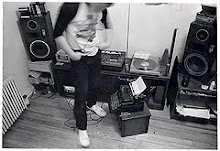 |
| The Hammond J-522 came out in 1971. |
I gave it a nudge to see if I could maybe lug it up the street to my house. No way. This sucker was heavy. I trotted home and five minutes later I was back with one of my son's old skateboards. Barely averting a hernia, I tipped the instrument onto it and rolled the organ up the street to my garage. Wiping it down I hoped for the best.
 A few days later I went back for a closer look. I plugged it in and bingo! It worked.
A few days later I went back for a closer look. I plugged it in and bingo! It worked.But wait, was that the classic rotating Leslie speaker sound I was hearing? And look, a little brass "H" nameplate on the front! I had found myself a Hammond organ.
Sure, it's a living room, church lady model (J-522, circa 1971), but this was a genuine Hammond. Cool. I dragged it to the cellar.
The top register was a little rough, some of the keys did not sound all the tones available from the rocker style drawbars switches, but it mostly worked. The built in rhythms, the bass pedals, volume pedal, the Leslie, the spring reverb and the entire lower register were all in good shape. O.K., the knobs drove crackling potentiometers, but they were functional. It had what looked like a 12-15" speaker in there, and it was pretty loud. I flipped through the cheesy beats. Very analog and vintage sounding. These where getting looped into Ableton, for sure.
 |
| Vintage dust balls. |
I decided to open it up. Inside: 40 years of dust balls. Now, I'm not too experienced with this stuff, but what the hell, it was free, so I dug deeper, removing set of screws after set of screws, and finally, the keys off of the top register.
This was a well built instrument. Everything was holding together snugly after 40 years. And the details were interesting: Every white key was held in with two tiny black screws and every black key by two tiny silver screws. Each key was molded with a number and letter on the underside to identify its place in the musical scale and on the physical keyboard. I applied some contact spray here and there, did a little vacuuming, cleaned up the keys and other surfaces.
 |
| Open Sesame |
I couldn't fix everything. The keys that didn't fire every tone must have had bad contacts somewhere I couldn't access, I figured. After trying to tunnel into one bad key I lost the tiny spring that worked its action. An hour later I found it perched on a transistor, only to have it boing away 3 more times. I finally got it back in place and called it a day.
All and all it did help. I got a few keys to work better on top, all the knobs now sound clean. The reverb was crisper with that layer of dust removed from the spring and chamber.
So now I'm having fun trying the combinations of tones you can get. Attempting bass lines with my feet. Quite exciting. I look forward to recording this beast.
 |
| Cool fisheye shot. |
I'd like to think they were left there by people knowing they would be rescued by someone like me. Someone who'd appreciate them.
The thought that this was tossed to be ultimately crushed under a heap of disposable diapers in a landfill makes me oh, so very sad.
